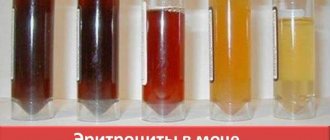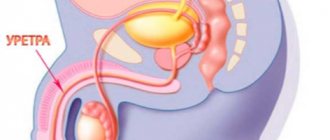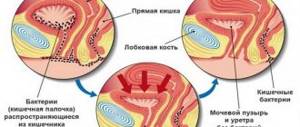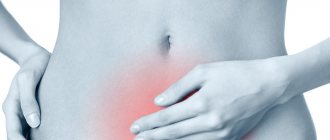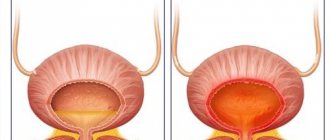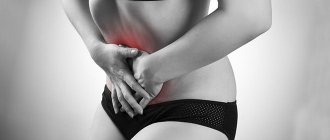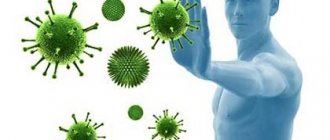Cystitis is an inflammation of the bladder that causes frequent urination with burning and pain, affecting women. Due to the wide urethra, the likelihood of infection entering the bladder increases. In most cases - E. coli.
Cystitis can be caused by infection or non-infectious factors
Inflammation can occur as a result of complications of diseases (diabetes mellitus, urolithiasis). Non-infectious factors can cause the disease.
Etiopathogenesis of allergic cystitis
The mechanism of disease development is similar to autoimmune processes.
But with allergic cystitis, the main provoking factor is the allergen, which begins to quickly spread through the bloodstream, and the immune system tries to fight back. People begin to experience negative manifestations, and they will become more violent with each subsequent contact with the antigen. Provoking factors for reactions:
- wearing synthetic underwear, contact of tissue with the genitals (which often happens in women), when small particles begin to easily penetrate the bladder due to a short urethra and cause inflammation;
- medications (antibiotics, herbal remedies, colloidal, infusion solutions) that can be excreted in the urine and distributed throughout the genitourinary system;
- abuse of sour fruits (vegetables), undigested particles of which can also settle in the ureter and kidneys;
- helminths (fungi) entering the body;
- household chemicals (powders, soaps) used when washing underwear, which first cause irritation of the labia, then allergic reactions, the development of inflammation;
- vaginal tampons, condoms, foam gels for bath and shower;
- exotic toilet paper;
- low-quality cosmetics.
Allergic cystitis begins to develop when allergens damage the muscle layer or mucous membrane of the ureter (urethra), leading to disruption of the outflow of urine. Most often, this is an unexpected phenomenon for people, when nothing seems to indicate the appearance of such discomfort, but the allergen suddenly invades through the external opening of the urethra or genitals.
The pathogenesis of the disease is caused by an increase in the level of eosinophils in the blood. Eosinophils are specific cells, the accumulation of which form an eosinophilic infiltrate, causing (as with ordinary cystitis) the development of inflammation.
REFERENCE! The severity of pathological changes will depend on the type of allergen and the amount entering the body.
Children are most susceptible to allergic reactions when they suddenly begin to complain of burning, stinging, and pain when urinating. But the reason turns out to be not infection, but allergens. In children, cystitis often develops in case of infection with helminths that can enter the genitourinary organs from the anus. In any case, the child’s complaints cannot be ignored. It is worth seeing a pediatrician in a timely manner and starting treatment.
Due to the structural features of children's genital organs, girls most often develop cystitis with the formation of a tumor-like body (on the inner surface of the bladder), which quickly increases in size. Less commonly, allergic cystitis is provoked by medications or food, the allergens of which enter the genitourinary system with the outflow of blood.
The note! Predisposed people - allergy sufferers - should generally avoid contact with substances that can cause allergies.
Cystitis in women can develop even from products (which seem safe at first glance) or detergents, toilet paper, condoms, tampons.
About the most important things: Cystitis, free treatment in Moscow, iodine deficiency
Diagnostic search
The standard diagnostic procedure is due to careful monitoring of the state of urine and blood structures, identification of the allergen that served as a causative factor in the development of inflammatory reactions in the bladder organ, and instrumental examination of the bladder.
Confirmation of the allergic genesis of the disease is due to the presence in urine and blood of specific leukocyte eosinophil cells, the function of which is phagocytic protection of the body from the introduction of foreign protein fractions.
A high concentration of peculiar granulocytes (eosinophils) indicates the presence of allergic reactions in the body.
Allergen detection is carried out by prick testing (the allergen is introduced into the skin through an injection) or a scarification test (by scratching). This technique tests 15 allergen samples simultaneously.
As an instrumental diagnosis, a cystoscopic examination is used, which can reveal symptoms characteristic of allergic cystitis, manifested by:
- thickening of the bladder walls,
- swelling of the mucous membrane in the posterior vesical zone and the mouth of the ureter,
- the presence of stenosis (narrowing) in the natural anti-reflux mechanism of the bladder (intramural ureter),
- decreasing the volume of the reservoir cavity.
In controversial situations, a microscopic examination of the biopsy is performed. Confirms AC - the presence in the muscular and submucosal layers of eosinophilic infiltrates, forming tumor-like thickenings on the reservoir cystic walls.
Symptoms of pathology
The symptoms are not much different from cystitis caused by bacteria. The main difference between allergic cystitis is itching in the groin area and external genitalia, which begins to bother you regardless of the location of the inflammatory process. Itching is a symptomatic harbinger of the disease. Next, inflammation in the genitourinary system and swelling of the genital organs begin to develop. Possible symptoms of allergic cystitis include:
- pain in the groin radiating to the hips;
- passing urine with stinging, dark unpleasant odor;
- itching, burning when urinating;
- impaired urine outflow due to swelling of the affected urethral tissues and decreased lumen;
- frequent urge to go to the toilet (usually at night);
- swelling of the labia in women, if the disease is caused by wearing synthetic underwear or using pads.
If you start the allergic process and do nothing, the disease will lead to increased temperature, weakness, purulent discharge from the urethra, and painful sensations in the lower abdomen.
REFERENCE! Anuria due to anaphylactic shock poses a danger, and bladder catheterization is urgently required.
Otherwise, the outflow of urine may stop completely. The condition will become critical.
Measures to prevent the development of the disease
To prevent the development of allergic inflammatory processes in the bladder tissues, it is necessary:
- strictly adhere to the rules of rational nutrition,
- use only hypoallergenic products in personal hygiene,
- refrain from drinking alcohol and minimize bad habits,
- avoid excess physical activity.
Cystitis of allergic origin is rarely diagnosed. Mainly in patients with allergies. The symptoms of damage to the bladder organ are radically different from other forms of cystitis.
Therefore, early examination and identification of the true cause of the disease will provide effective treatment, without the possible development of relapses in the future.
From the point of view of belonging, cystitis is an inflammatory disease, the localization of which is the lumen of the bladder. This pathological condition occurs with equal frequency under the influence of infectious and non-infectious factors. One of the potential causes of the development of this disease is a hypersensitivity reaction. Various factors can lead to the development of a local allergic reaction, including poor nutrition, concomitant diseases of organs and systems, as well as the use of certain cosmetics, personal hygiene items and underwear.
How to identify an allergen in children and adults?
Unfortunately, it is almost impossible to identify allergic cystitis on your own. If you suspect it, you should see a doctor and undergo examination.
First of all, the doctor:
- listen to complaints;
- will palpate the abdominal cavity;
- establish a history of pathology;
- will redirect you to undergo laboratory tests to confirm the diagnosis.
The main test to be taken is urine to identify the number of eosinophils - cells that confirm the allergic nature of the disease.
Regardless of the form of allergy, the recognition and determination of the allergen is based on an allergy test. Additional methods that must be performed to distinguish eosinophilic infiltrate from a malignant tumor or cystitis caused by a bacterial infection:
- cytoscopy to identify a tumor body, thickening of the walls of the bladder;
- cytoscopy with examination of the bladder cavity through the introduction of a small camera;
- a biopsy with the removal of a piece of tissue from the walls of the bladder to determine the etiology of the tumor.
It is most difficult to identify cystitis in young children, when there is only a slight deterioration in health. In addition, if the baby is constantly in a diaper, then it is almost impossible to detect increased urination in time.
A distinctive feature of the development of allergic cystitis in children is its fulminant course due to the imperfection of the immune system. This is what mothers should understand and be more attentive to their children. Girls require special attention because, due to their short urethra, the penetration of infection into the body and the development of inflammation is practically unimpeded.
In boys, the foreskin is narrowed, so it is less common, but cystitis can also begin to develop.
Of course, there are a great many known allergens in nature and it is difficult to identify the only one that causes cystitis. To make an accurate diagnosis, doctors often conduct prick tests as one of the accurate, painless examination methods. Helps identify allergens to a particular substance in case of redness and swelling of the skin at the site of application.
The best remedy for allergies?!
Diagnostics
To identify cystitis of allergic origin, the doctor prescribes the following diagnostic procedures:
- Ultrasound. Ultrasound examination of the mucous membranes of the bladder helps to detect changes characteristic of a long-term allergic reaction - thickening of the walls of the organ, the appearance of tumor-like formations. The volume of the bladder decreases, the walls become deformed.
- Cystoscopy. When examining the mucous membranes, swelling of the posterior wall and bladder triangle is detected. The mouth of the urethra also swells. Sometimes a tumor is detected that forms from an infiltrate with light plaques, a narrowing of the intramural portion of the ureter.
- General blood analysis. Reflects signs characteristic of the inflammatory process caused by an allergic reaction - an increase in the number of eosinophils and leukocytes, a change in ESR.
- General urine analysis. Helps detect the presence of protein, salts, bacteria. Used to exclude the infectious nature of cystitis.
- Biopsy. Used when it is impossible to determine the cause of unpleasant symptoms. Examination of tumor tissue makes it possible to determine its nature.
- Histological examination. It is carried out after surgical removal of the tumor.
Ultrasound examination of the mucous membranes of the bladder helps to detect changes characteristic of a long-term allergic reaction - thickening of the walls of the organ, the appearance of tumor-like formations.
When examining the mucous membranes with a cystoscope, swelling of the posterior wall and bladder triangle is detected.
A general blood test for cystitis reflects signs characteristic of the inflammatory process caused by an allergic reaction - an increase in the number of eosinophils and leukocytes, a change in ESR.
A general urine test is used to exclude the infectious nature of cystitis.
Treatment method for allergic cystitis
With allergic cystitis (as opposed to the bacterial form), the main goal is to identify and eliminate the allergen and only then begin to deal with its consequences. This means that, first of all, it is important for patients to:
- isolate yourself from all contacts with possible allergens in order to avoid deterioration of well-being;
- observe the rules of hygiene;
- review your diet, eliminate irritating foods.
When allergic cystitis is diagnosed, treatment at the initial stage is medication. The main drugs are antihistamines (Suprastin, Tavegil, Cetrin), with intravenous administration in the first days to relieve unpleasant symptoms (itching, burning) and thereby provide first aid to the victim. Next, the doctor will develop an optimal treatment regimen. Drugs used:
- anti-inflammatory drugs to suppress spasms and inflammation;
- glucocorticosteroids (Hydrocortisone, Dexamethasone) to improve blood circulation and relieve swelling;
- drugs from the NSAID group (Celecoxib, Nimesil) with a complex effect on the disease, providing anti-edematous, analgesic effects;
- diuretics to enhance diuresis and remove harmful toxins from the bladder;
- antispasmodics to relieve pain, eliminate spasms of smooth muscles of the urinary tract.
For cystitis caused by worms, helminths, fungal allergens, anthelmintic or antifungal drugs are prescribed, respectively.
As remission is achieved or if it is impossible to identify the allergen, desensitization therapy is carried out in order to somehow neutralize the negative impact.
Auxiliary techniques for allergic cystitis:
- physiotherapy (phonophoresis, electrophoresis, magnetotherapy, magnetophoresis), relieving spasms, inflammation, bladder tension;
- amplipulse therapy, SUV irradiation with a diuretic effect on the organs of the genitourinary system;
- sitz baths with the addition of herbs to improve bladder tone and relieve pain;
- heat therapy;
- infrared irradiation.
If severe pain occurs in women with cystitis, then novocaine blockades can be prescribed. During menopause, it is recommended to use vaginal suppositories and ointments with estrogen.
Medicinal herbs with decongestant, antihistamine, diuretic, and anti-inflammatory effects will increase the effectiveness of drug treatment for allergic cystitis. Infusions and decoctions are prepared from herbs for oral administration and douching: yarrow, bearberry, chamomile, lingonberry leaf.
Cranberries (fresh or frozen) help well. Relieves pain, inflammation, suppresses bacterial microflora.
Advice! Even minor signs of allergic cystitis cannot be ignored.
If allergic cystitis is not treated, complications are inevitable. Allergens that have settled in the genitourinary system can continue their march, resulting in the development of urethritis, pyelonephritis, and renal colic.
Treatment of cystitis in women in 1 day - without pills. ATTENTION! - read the contraindications!
Allergy prevention
For hypersensitive people prone to allergic reactions, it is very important to follow preventive measures:
- review your diet, exclude harmful leavening agents, dyes, and flavorings in sausages, mayonnaise, ketchup, and processed foods;
- use hypoallergenic household chemicals and high-quality intimate pads;
- maintain personal hygiene;
- take any medications only after being prescribed by a doctor;
- take measures to strengthen the immune system;
- promptly treat infectious diseases.
Causes and risk factors
There are many factors that can cause an allergic reaction and, as a result, symptoms of cystitis. The allergen will be different for all people. Allergies are caused by the following reasons:
- taking medications and medications;
- eating certain foods;
- presence of food additives in food;
- contact with chemicals;
- use of low-quality contraceptives;
- use of allergenic cosmetics and personal hygiene products.
